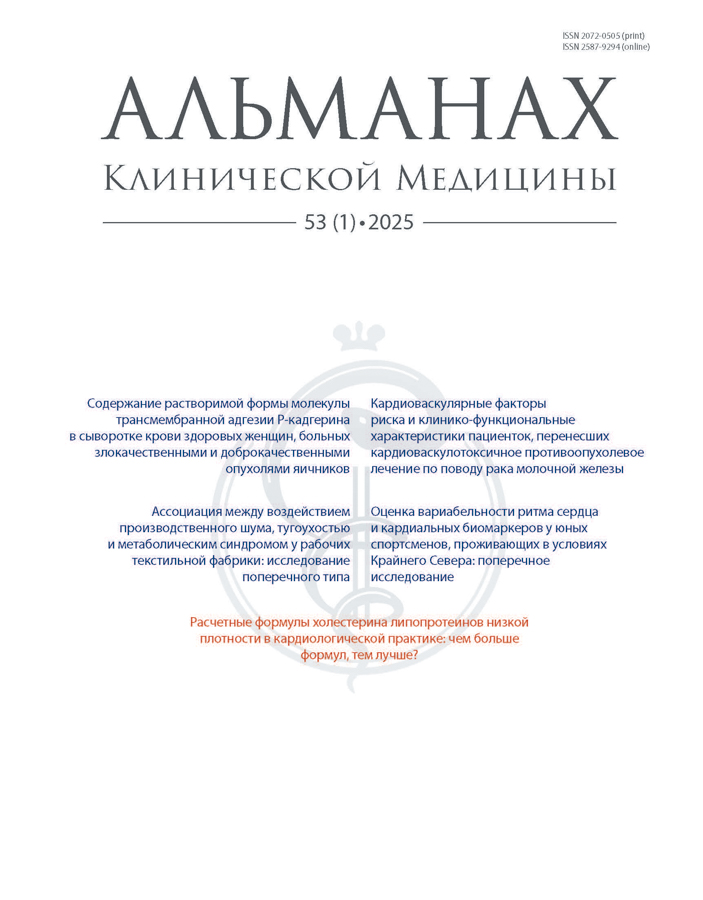Анализ заболеваемости и смертности как основа совершенствования оказания медицинской помощи пациентам с раком предстательной железы в Московской области
- Авторы: Балканов А.С.1, Базаев В.В.1, Гуров А.Н.1
-
Учреждения:
- ГБУЗ МО Московский областной научно-исследовательский клинический институт им. М.Ф. Владимирского
- Выпуск: Том 46, № 1 (2018)
- Страницы: 88-93
- Раздел: ОРИГИНАЛЬНЫЕ СТАТЬИ
- URL: https://almclinmed.ru/jour/article/view/762
- DOI: https://doi.org/10.18786/2072-0505-2018-46-1-88-93
- ID: 762
Цитировать
Полный текст
Аннотация
Актуальность. Рак предстательной железы (РПЖ) – одна из самых часто диагностируемых опухолей у мужчин, что обусловливает актуальность изучения современных тенденций заболеваемости данной онкопатологией и смертности, с ней связанной, в свете оптимизации медицинской помощи этой категории пациентов.
Цель – выявление современных тенденций заболеваемости РПЖ и смертности в Московской области.
Материал и методы. Для анализа заболеваемости и смертности при РПЖ в период с 2011 по 2016 использованы данные, полученные из годовых форм федерального статистического наблюдения по оказанию медицинской помощи населению, а также из Московского областного канцер-регистра, содержащего региональные сведения о больных с впервые выявленной онкопатологией.
Результаты. В период с 2011 по 2015 количество выявленных случаев РПЖ у мужчин, проживающих в Московской области, увеличилось на 38%, при этом число ежегодно выявляемых случаев РПЖ в среднем росло на 8,8%. В 2016 зафиксировано снижение числа новых случаев РПЖ (1765 случаев) на 8,7% по сравнению с показателем 2015 Заболеваемость РПЖ в период с 2011 по 2015 возросла с 42,5 до 57,8 на 100 тыс. мужского населения, что обусловлено, прежде всего, изменением данного показателя в возрасте 50 лет и старше. В 2016 заболеваемость РПЖ снизилась до 52,2 на 100 тыс. Пик заболеваемости РПЖ во все годы наблюдения приходился на возрастную группу 70–79 лет. В 2016 отмечено незначительное снижение смертности от РПЖ – до 16,6 на 100 тыс.
Заключение. Полученные данные могут быть использованы для оптимизации медицинской помощи пациентам с РПЖ в Московской области.Ключевые слова
Об авторах
А. С. Балканов
ГБУЗ МО Московский областной научно-исследовательский клинический институт им. М.Ф. Владимирского
Автор, ответственный за переписку.
Email: andreybalkanov@yandex.ru
Балканов Андрей Сергеевич – доктор медицинских наук, заведующий радиологическим отделением.
129110, Москва, ул. Щепкина, 61/2–7, +7 (495) 681 19 07
РоссияВ. В. Базаев
ГБУЗ МО Московский областной научно-исследовательский клинический институт им. М.Ф. Владимирского
Email: fake@neicon.ru
Базаев Владимир Викторович – доктор медицинских наук, профессор, заведующий урологическим отделением.
129110, Москва, ул. Щепкина, 61/2
РоссияА. Н. Гуров
ГБУЗ МО Московский областной научно-исследовательский клинический институт им. М.Ф. Владимирского
Email: fake@neicon.ru
Гуров Андрей Николаевич – доктор медицинских наук, профессор, руководитель научно-организационного отдела.
129110, Москва, ул. Щепкина, 61/2
РоссияСписок литературы
- Hassanipour-Azgomi S, Mohammadian-Hafshejani A, Ghoncheh M, Towhidi F, Jamehshorani S, Salehiniya H. Incidence and mortality of prostate cancer and their relationship with the Human Development Index worldwide. Prostate Int. 2016;4(3): 118– 24. doi: 10.1016/j.prnil.2016.07.001.
- Гуров АН, Балканов АС, Катунцева НА, Огнева ЕЮ. Анализ онкозаболеваемости и смертности населения Московской области за 2014 год. Альманах клинической медицины. 2015;(41): 6–11. doi: 10.18786/20720505-2015-41-6-11.
- Ondrusova M, Ondrus D, Karabinos J, Muzik J, Kliment J, Gulis G. Trends in prostate cancer incidence and mortality before and after the introduction of PSA testing in the Slovak and Czech Republics. Tumori. 2011;97(2): 149–55. doi: 10.1700/667.7775.
- Parkin DM, Bray F, Ferlay J, Pisani P. Global cancer statistics, 2002. CA Cancer J Clin. 2005;55(2): 74–108. doi: 10.3322/canjclin.55.2.74.
- Gilbert SM, Pow-Sang JM, Xiao H. Geographical factors associated with health disparities in prostate cancer. Cancer Control. 2016;23(4): 401–8. doi: 10.1177/107327481602300411.
- Pakzad R, Mohammadian-Hafshejani A, Ghoncheh M, Pakzad I, Salehiniya H. The incidence and mortality of prostate cancer and its relationship with development in Asia. Prostate Int. 2015;3(4): 135–40. doi: 10.1016/j.prnil.2015.09.001.
- Welch HG, Albertsen PC. Prostate cancer diagnosis and treatment after the introduction of prostate-specific antigen screening: 1986– 2005. J Natl Cancer Inst. 2009;101(19): 1325–9. doi: 10.1093/jnci/djp278.
- Helgstrand JT, Røder MA, Klemann N, Toft BG, Brasso K, Vainer B, Iversen P. Diagnostic characteristics of lethal prostate cancer. Eur J Cancer. 2017;84:18–26. doi: 10.1016/j.ejca.2017.07.007.
- Chirpaz E, Colonna M, Menegoz F, Grosclaude P, Schaffer P, Arveux P, Lesec'h JM, Exbrayat C, Schaerer R. Incidence and mortality trends for prostate cancer in 5 French areas from 1982 to 1996. Int J Cancer. 2002;97(3): 372–6. doi: 10.1002/ijc.1603.
- Torre LA, Bray F, Siegel RL, Ferlay J, Lortet-Tieulent J, Jemal A. Global cancer statistics, 2012. CA Cancer J Clin. 2015;65(2): 87–108. doi: 10.3322/caac.21262.
- Gomella LG, Liu XS, Trabulsi EJ, Kelly WK, Myers R, Showalter T, Dicker A, Wender R. Screening for prostate cancer: the current evidence and guidelines controversy. Can J Urol. 2011;18(5): 5875–83.
- Bratt O, Garmo H, Adolfsson J, Bill-Axelson A, Holmberg L, Lambe M, Stattin P. Effects of prostate-specific antigen testing on familial prostate cancer risk estimates. J Natl Cancer Inst. 2010;102(17): 1336–43. doi: 10.1093/jnci/djq265.
- D'Amico AV, Chen MH, Renshaw A, Loffredo M, Kantoff PW. Long-term follow-up of a randomized trial of radiation with or without androgen deprivation therapy for localized prostate cancer. JAMA. 2015;314(12): 1291–3. doi: 10.1001/jama.2015.8577.
- Turk H, Celik O, Un S, Yoldas M, İsoglu CS, Karabicak M, Ergani B, Koc G, Zorlu F, Ilbey YO. Predictive factors for biochemical recurrence in radical prostatectomy patients. Cent European J Urol. 2015;68(4): 404–9. doi: 10.5173/ceju.2015.606.
- Kotwal AA, Schonberg MA. Cancer screening in the elderly: a review of breast, colorectal, lung, and prostate cancer screening. Cancer J. 2017;23(4): 246–53. doi: 10.1097/PPO.0000000000000274.
Дополнительные файлы








